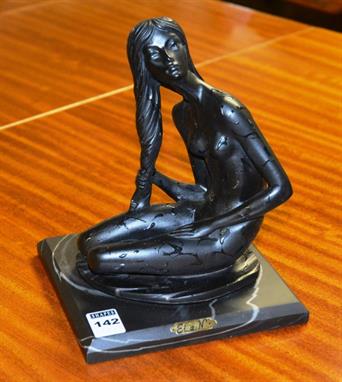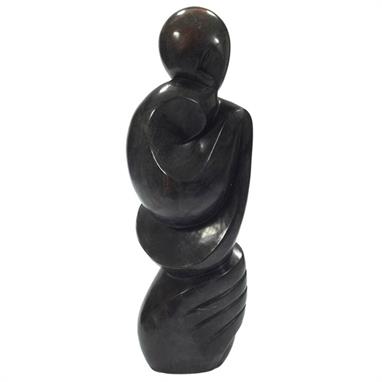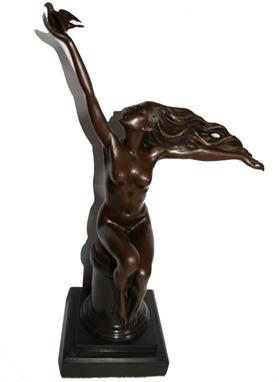ADOLFO CIPRIANI `ISPIRAZIONE` CARVED MARBLE ON PED Adolfo Cipriani (ITALIAN, active 1880-1930) carved marble sculpture titled `Ispirazione` depicting a standing woman in dress. Includes white marble pedestal. Figure signed and titled to back of base. Figure measures approx. 33 1/2" height (85cm). Pedestal Measures 44 3/4" height (113.6cm). Overall height of approx. 78 1/4" (198.7cm).
We found 6684 price guide item(s) matching your search
There are 6684 lots that match your search criteria. Subscribe now to get instant access to the full price guide service.
Click here to subscribe- List
- Grid
JASON ET LA TOISON D’OR Par Henri-Léon GREBER (1855-1941) MATÉRIAU :Marbre blanc Signé et daté 1912 H. 200 cm, L. 77 cm, P. 88 cm A WHITE MARBLE FIGURE OF JASON AND THE GOLDEN FLEECE By Henri-Leon GREBER (1855-1941) Signed and dated 1912 78.74 in. high, 30.31 in. wide, 34.65 in. deep Accidents et manques visibles Cette sculpture monumentale en marbre blanc est l’oeuvre d’Henri-Léon Greber, né à Beauvais en 1855. Il fut l’élève notamment de Frémiet et Mercié. Il exposa fréquemment aux salons des Artistes Français où il obtint de nombreuses récompenses telle la médaille de première classe en 1903. L’oeuvre ici présentée figure Jason, le corps musclé et dénudé, bondissant de joie après son succès de la quête de la Toison d’Or. Il arbore fièrement celle-ci sur le côté ainsi qu’un large bouclier ouvragé posé sur son avantbras. Cette scène célèbre de la mythologie raconte comment Jason, afin de reconquérir le trône usurpé par son oncle Pélias, fut envoyé par ce dernier à la recherche de cette Toison. S’il y parvenait, Pélias s’était engagé à lui rendre le royaume. Cette oeuvre exprime toute la joie et l’héroïsme de Jason qui sut braver de grandes difficultés pour obtenir cette fourrure et laver l’honneur de sa famille.
Salvador Dali, Spanish 1904-1989- "Perseus, Hommage à Venvenuto Cellini" (Perseus, Hommage to Benvenuto Cellini), publ. 2049 Obra Contemporanea; bronze with gold patina on a marble plinth, signed, numbered 245/350 and inscribed `FRA`, height 19cm excluding plinth, 24cm with plinth, (may be subject to Droit de Suite) Note: A certificate of authenticity from Artco, France accompanies this lot. This sculpture is reference in `The Hard and the Soft` by R and N Descharnes, page 172 and 173
Salvador Dali, Spanish 1904-1989- "Triton Ailé" (Winged Triton), publ. 2049 Obra Contemporanea; bronze with gold patina on a marble plinth, numbered 257/350 and inscribed `FRA`, height 15.5cm excluding plinth, 22.5cm with plinth, (may be subject to Droit de Suite) Note: A certificate of authenticity from 2049 Obra Contemporanea accompanies this lot. This sculpture is reference in `The Hard and the Soft` by R and N Descharnes, page 164 and 165
An Italian polychrome marble portrait bust of a Nubian, 19th century, with a finely modelled head and clothes, his turban in white marble with grey marble stripes, his jacket in rouge marble with blue lapis lazuli buttons, over a white marble vest, on a white marble socle plinth with grey marble insert, unsigned, 62cm high 42cm wide This portrait bust forms part of a tradition in Italian sculpture of coloured marbled statues, which became popular in the 17th century, with the Nubian emanating in particular from Venetian workshops. With the 18th century and the spread of the Grand Tour, the taste for such busts increased, and pairs became an important feature in interior decoration, demonstrating not only the owner's taste, but also his extensive and exotic travels.
Barney Seale RBA (1896-1957), A bust of Augustus John, bronze with a green patina, signed and dated `37, raised on a black marble plinth bearing a bronze plaque with the sitter`s signature, the bust 22cm (8 3/4in) high, overall 29cm (11 1/2in) high. Literature: Stanley Casson (ed.), Sculpture of Today, The Studio Ltd, London, 1939, another cast illustrated p. 51. According to Casson, John highly approved of Seale`s sculpture and added his signature to the original model
SIR GEORGE JAMES FRAMPTON, RA PETER PAN bronze, fine rich even dark patina, signed with monogram, dated 1919 and inscribed with the initials PP within a circle, on Conemara marble plinth, 48cm h, 52.5cm h overall, sold with a letter from Frampton`s widow acknowledging the price £105) paid for the present cast (2) Cast in 1919. Frampton`s Peter Pan by the Serpentine in Kensington Gardens has always been one of the most admired works of public sculpture in Britain, having attained virtually iconic status. Its originality and the naturalism of the innocent child appealed to an Edwardian England in the aftermath of the Boer war and its poetic newness accorded well with the mood of youthful optimism for the new century, in the years leading up to the World War One. How different it must have seemed to that other great work of the `New Sculpture` Movement, Sir Alfred Gilbert`s Shaftesbury Memorial (Eros) of 1886-93. Peter Pan was exhibited at the Royal Academy in 1911. It was commissioned anonymously by the book`s author Sir J M Barrie and erected, in great secrecy, on the night of the 29-30 April 1912 so that its appearance the next day would seem magical. `It is placed at the spot where Peter Pan lands for his nightly visit to the Gardens` observed Sir Edward Gleichen (London`s Open-air Statuary, 1928). The Adventures of Peter Pan was published in 1904 and first performed at the Duke of York`s Theature on 27 December of the same year. Barrie gave the copyright to Great Ormond Street Hospital for Children in April 1929. Frampton`s range was unusually wide, as he was a versatile exponent of several branches of the applied and decorative arts, a medallist, a skilful enameller, maker of jewellery and decorator working in stone, plaster and other media. He trained as an architect before studying at the Royal Academy Schools and in Paris. In Belgium he was strongly influenced by the new developments there. He was in reality himself an English Symbolist and one of the original members of the Art Workers Guild, serving as Master in 1902. He was born in 1860 and died in 1928, having been knighted in 1908. The present bronze is one of the small number of reductions cast for Frampton up to about 1920. The letter from Frampton`s widow, which accompanies the lot is of interest for a number of reasons, not least for giving the high price (£105) the cast commanded: Dear Mr-, Thank you for your letter - I am very sorry to hear that Mr Mitchells Memorial is neglected and hope it will be cleaned satisfactorily. As the the Peter Pan statuette there will certainly be no more of these produced - I have just succeeded in finding a record of what must have been the last one done & the price paid for it was £105. The Statue is strictly copyright & we have decided that no further replicas of it or any part of it shall be made - Since my husband`s death I have had repeated trouble with infringements & have had to take very drastic measures to try & stop the abuse - Some of the statuettes he presented to old friends & some were sold in the ordinary way. I have not had time to trace the complete record of them but I daresay this information will be sufficient for your purposes. With kind regards Yrs sincerely Christabel A Frampton` Other examples were sold Sotheby`s London, 9 July 2002 (£36,000), 14 December 2001 (£48,000) and 26 June 2001 (£45,000). Literature: Beattie (Susan), The New Sculpture, 1983, pp218-219. Cooper (Jeremy), Nineteenth-Century Romantic Bronzes, 1975, pp 85-85. Read (Benedict), Victorian Sculpture, 1983, pp315-7 and 365. Jexxard (Andrew), George Frampton (unpublished MA thesis Leeds University). Bilbey (Diane), British Sculpture 1470 to 2000 Concise Catalogue of the Collection at the Victoria and Albert Museum, 2002, Nos 403-409. In fine original condition
Large C. Jere sculpture Large C. Jere sculpture, 1960s, brass form over a solid black marble base, original finish, signed on base, date obscured, 14"w x 36"h, very good original condition No repairs. Sturdy and structurally sound. Two tiny nicks to the top edge of the marble base. No bends or dents.
C. Jere Comet Spray sculpture C. Jere Comet Spray sculpture, arched brass support holds a spray of thirteen silver colored metal rods with ball tips, cylinder marble base, original finish, signed on base, 36"w x 12"d x 38"h, excellent original condition Light wear consistent with age. No problems.
David Gopito marble sculpture David Gopito marble sculpture, "Shyness", 2003, Zimbabwe, Africa, hand-carved Serpentine stone, signed "D. Gopito SN 22661", includes the original purchase receipt and a Certificate of Authenticity, 6.5"w x 3.75"d x 19.25"h, mint condition Mint condition. No chips or cracks. No repairs. No problems.
1966: 1916 Rising commemoration sculpture of `The Dying Cúchulainn` by Oliver Sheppard 1966 official small scale sculpture of `The Dying Cúchulainn` by Oliver Sheppard. Manufactured under license from The Commissioner of Public Works. Mounted on marble. The large scale version is located today in the G.P.O P Measurements: 9 by 3.5in., 22.5 by 8.75cm.
1966: 1916 Rising commemoration sculpture of `The Dying Cúchulainn` by Oliver Sheppard 1966 official small scale sculpture of `The Dying Cúchulainn` by Oliver Sheppard. Manufactured under license from The Commissioner of Public Works. Mounted on marble. The large scale version is located today in the G.P.O. P Measurements: 9 by 3.5in., 22.5 by 8.75cm.
Sir Edgar Bertram Mackennal (Australian, 1863 - 1931) "Salomé" bronze sculpture. Female nude first cast in the year 1896, Signed B.MACKENNAL LONDON. SALOME, raised on a circular green marble base, Height 34 cms. Salome became a cult figure after Oscar Wilde's highly controversial play of the same name in 1891 and was banned in England, it was not until 1905 that play was staged in London. The sculpture was first exhibited at the Royal Academy in 1897, exhibition number 2053 with a price of 25 pounds. Salomé was cast only in this size and was a resounding success at the exhibition and met with critical acclaim for it's symbolic eroticism.
Alfred Drury RA, (British, 1856-1944), "The Age of Innocence", a late 19th Century patinated bronze shoulder length Bust of a young girl, her hair tied up high and with hair band, her face with a calm expression, the reverse signed A Drury and mounted upon a square green variegated marble socle with plinth base, approx 39cm overall height. Note: The Age of Innocence is probably the best of Drury's many fine studies of children, such as Griselda and Saint Agnes. The marble version was exhibited at the Royal Academy in 1897, and according to M. H. Spielmann, author of British Sculpture and Sculptors of Today (Studio Special Number 1901) 'still further heightened the public appreciation of Mr. Drury's talent. So widely was it appreciated that when the bust was "published" in a small size a very considerable number were bought up at once.'
A Roman carved stone model of a falcon, on a later marble basePlease note, there have been differences of opinion concerning the probable date of make of this piece of sculpture. Academics at the British and Ashmolean Museums have reputedly asserted the piece to be of eastern Mediterranean 2nd century AD origin, possibly Palmyra. Others have suggested later make
Fourteen spelter metal and carved stone sculptures, 20th century, to include maidens, cherubs and an animal group, together with a carved marble and alabaster sculpture and a pair of spelter figural table lamps, 57cm high, (14) (a/f). (It is the buyer`s responsibility to ensure that electrical items are professionally rewired for use).
A rare Renaissance bone panel of Laocoön, mid-16th century, the small section carved after the antique marble between zigzig and fine gadroon borders, 6.5cm This plaque probably formed part of the side of a casket where bone was the usual choice of material. The zigzag ribbon at the base was a common motif of the period - see the bone casket in the British Museum, illustrated in 'Objects of Virtue', Luke Syson and Dora Thornton, 2004, pls 41, 42. Bone carvings, such as the present example, are traditionally attributed to the Florence studio of the Embriachi family, although it is possibly too early here. The famous Roman marble of Laocoön and his sons, itself a copy of the Greek, was unearthed in a vineyard in Rome in 1506 and caused something of a sensation. This, and other comparable sculpture, led to a sea-change in the way the human figure was viewed after the Classical and characteristic of the Renaissance. It was Laocoön who advised his fellow Trojans to reject the Greeks' gift of the wooden horse. While his advice was debated, two huge snakes suffocated his sons. CONDITION REPORT: Formerly attached to a casket.
The Old Tom Morris Award presented to Jaime Ortiz-Patiño by the GCSAA in 1999, metalware sculptural group by Michael Roche titled ‘Old Tom, Keeper of the Greens’, depicting the ‘father of golf’ on the Swilken Bridge at St Andrews, set on a marble plinth, with wooden base and inscribed presentation plaque, 31 by 31cm., 12 1/4 by 12 1/4in.; sold together with a resin bronze wall plaque depicting Old Tom similarly titled to the above sculpture (2)
16 Miscellaneous golf trophies, VII Sherry Cup for amateur golf Sotogrande 1976; sculpture inscribed SGC, crossed clubs, marble plinth; two EPNS card trays, Coups S.A.A., Comte De Barcelona 1st Prix & 2nd Prix; five silver plated dishes, Association of Senior Golfers de France, 1931; an art deco silver plated dish & cover; four miniature cups variously inscribed for club competitions at Valderrama; gilt miniature cup inscribed Golf d’Evians; and a Bolivian trophy figurine
Sculpture of Swooping Eagle by Walenty Pytel on chamfered marble plinth with japanned metal column, total height approx. 29``, Walenty Pytel is a Polish-born (1941) contemporary artist based in the United Kingdom, recognised as a leading metal sculptor of birds & beasts. His creations are often inspired by nature & his artworks include the Jubilee Fountain in New Palace Yard, Westminster, a piece titled Take Off which is located at Birmingham Airport, West Midlands & Europe`s largest (in 1979) metalwork sculpture, The Fossor, at the headquarters of J.C. Bamford in Rocester, Stafffordshire













![VITTORIO CARADOSSI [ITALIAN, 1861-1909] CARVED CARRARA MARBLE SCULPTURE OF A NEREID, H 83": Carved Carrara marble group](http://lot-images.atgmedia.com/SR/33875/2890132/2001-201382210175_468x382.jpg)
![GREDIAGA ANTONIO KIEFF [CANADIAN/SPANISH B.1936] POLISHED BRONZE SCULPTURE H 36" W 7" "CANTE JONDO 8: Signed a](http://lot-images.atgmedia.com/SR/33875/2890132/2053-2013822101923_468x382.jpg)
![MARSHALL FREDERICKS [AMER. 1908-1998], BRONZE AMERICAN EAGLE, 7" H. X 6" L. X 7 1/2" D.: `Ann Arbor War Memori](http://lot-images.atgmedia.com/SR/33875/2890132/2057-2013822101933_468x382.jpg)



![ROLAND PARIS [1894-1945], ART DECO COLD PAINTED BRONZE SCULPTURE OF PUNCHINELLO, H 10 1/2", L 3": The black marble](http://lot-images.atgmedia.com/SR/33875/2890132/2157-201382210248_468x382.jpg)
![PIERRE LE FAGUAYS [FAYRAL - FRENCH 1892-1962] , ART DECO METAL SCULPTURE, H 16", GIRL DANCING: She holds cymbals. Green](http://lot-images.atgmedia.com/SR/33875/2890132/2323-2013822103153_468x382.jpg)













![ERNEST GUILBERT [FRENCH, B.1848], BRONZE SCULPTURE, H 28", `SEPARATING THE FOES`: With a 1" round marble base. Sign](http://lot-images.atgmedia.com/SR/33875/2888114/2094-2013715111729_468x382.jpg)
























